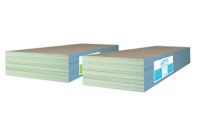Reducing Spinout With Abuse-Resistant And Impact-Resistant Gypsum Panels
Minimizing Screw Spinout

Gypsum panel product manufactures started receiving complaints that drywall screw heads did not seat properly when attaching AR/IR panels to 20-EQ studs.

Gypsum panel product manufactures started receiving complaints that drywall screw heads did not seat properly when attaching AR/IR panels to 20-EQ studs.


More than two decades ago, abuse-resistant gypsum panels and impact-resistant gypsum panels were developed for application in high-traffic and heavy-wear areas. Often referred to as “AR” panels and “IR” panels, these products have denser cores and tougher, more resilient facers. AR/IR panels are heavier than traditional 5/8-inch type X gypsum wallboard by an average of at least 25 percent. The ratings or performance of the AR/IR panels—Levels 1 to 3—are defined by ASTM C1629 Standard Classification for Abuse-Resistant Non-Decorated Interior Gypsum Panel Products and Fiber-Reinforced Cement Panels. Hospitals, schools, college dormitories, gymnasiums, and minimum-security prisons are a few examples of places where these panels provide a high-performance alternative to other technologies.
At the time AR/IR panels were introduced—the 30-mil steel stud—commonly referred to as a 20-gauge drywall/curtainwall stud or simply a 20-gauge stud, was standard in non-load bearing steel stud framed walls. However, within the last 15 years, metal framing manufactures have introduced a family of studs with thinner steel of greater hardness, engineered to achieve the same height limitations/structural performance as 30-mil studs. Also known as “20-EQ” studs, these equivalent metal framing studs have a 19-mil designation. Subsequently, and to minimize confusion, the metal framing manufacturers moved away from using the term “gauge” and switched to “mil” thickness. 20-EQ studs vary in the marketplace from a measured thickness of 19 to 23 mils, so for simplicity we will refer to them as 20-EQ in this article.
20-EQ studs work well in most drywall framing situations previously using 30-mil studs. However, gypsum panel product manufactures started receiving complaints that drywall screw heads did not seat properly when attaching AR/IR panels to 20-EQ studs.
Conversations between frustrated contractors and the technical departments of both Gypsum Association member companies and the Association’s technical department revealed that contractors were often using 20-EQ studs on these projects, reasoning that they were equivalent to the 30-mil studs on all performance parameters, not just structural parameters.
A Phenomenon
The combination of 20-EQ studs and denser AR/IR panels lends itself to a phenomenon that members of the construction industry call “screw spinout.” The mil thickness of a 20-EQ stud is not always thick enough to allow screw threads to grab hold. As a result, the screw continues to spin and the head remains above the surface of the panel rather than properly seated in the panel surface. Inquiries to the technical service groups suggested that several factors contributed to the screw spinout issue.
To better understand this issue, field testing witnessed by a third-party engineering firm was conducted for the Gypsum Association, in conjunction with representatives from the Steel Framing Industry Association, and the American Iron and Steel Institute. Field tests showed that steel stud thickness is a factor in the occurrence of screw spinout during the installation of AR/IR panels. The evidence demonstrated that screw spinout rates increased when AR/IR panels were attached to 20-EQ studs as opposed to 30-mil studs. Notably, several parameters contribute to screw spinout.
The Causes
Screw design proved to be the single most critical factor. The third-party engineering firm attested to the fact that using self-drilling (drill point) screws on a thinner steel stud generated higher screw spinout rates (up to 40 percent with 20-EQ studs in one instance). Additionally, this study found that the use of traditional fine thread, sharp-point drywall screws produced comparatively lower spinout rates when AR/IR panels were attached to either thickness of stud.
Screw gun speed is also a factor in avoiding screw spinout when mounting AR/IR panels. Screw guns are available with speeds ranging from as low as 2,500 RPM to well over 5,000 RPM. The field study showed that slower speeds help decrease the incidence of screw spinout when installing AR/IR panels on thinner studs.
A Practical Approach
The Gypsum Association has taken a conservative, yet practical approach to the issue of screw spinout on AR/IR panels for several reasons. The association understands that screw design is specified in ASTM standards. While slow gun speeds can be recommended, the GA recognizes that these factors are harder to control in the field than stud thickness. In fact, screw design is rarely found in specifications from the designer. It is also convenient for installers to rely on a single screw type across a project, or simply use whatever screw is readily available to keep the job moving. Contractors want to achieve rapid installation and commonly use screw guns with speeds of 4,000 RPM or greater.
When spinouts occur in higher rates, it hampers work timelines and creates scheduling issues on the job. To minimize issues in the field, the Gypsum Association, on behalf of its member companies, recommends the use of a minimum 30-mil steel stud when attaching AR/IR panels. GA-216-2016 Specification for the Application and Finishing of Gypsum Panel Products, included the following language (as revised per an errata), in section 2.2.12.4, “Where studs complying with ASTM C645 are used to receive ‘Abuse Resistant or Impact Resistant Gypsum’ panels, they shall be not less than 0.0312 inch design thickness.” This has been changed in GA-216-2018 to instead reference the base metal thickness of 0.0296 inch.
However, the association and its members also recognize the study results. While we will not be changing our formal guidance for reasons discussed above, we are offering additional advice. If the decision is made to install AR/IR panels on 20-EQ studs, i.e. studs with a measured minimum thickness of 0.019 inches, the Gypsum Association recommends that sharp point fine thread or sharp point high-low thread screws be used. The use of drill point screws on any steel stud with a thickness under 33-mil studs is not recommended per ASTM C954. When sharp point fine thread or sharp point high-low thread screws are used to attach AR/IR panels to 20-EQ studs, reducing screw gun speeds to 2,500 RPM will help minimize the occurrence of screw spin out.
How to Minimize Issues
What can commercial drywall contractors do to minimize issues when abuse-resistant panels or impact-resistant panels are part of a project? Here are a few suggestions:
- Review construction documents carefully when bidding a project.
- If 30-mil steel studs are not specified where AR/IR panels are specified, raise the issue with the general contractor who can alert the architect and or owner. The architect or owner can then decide how to proceed.
In conclusion, screw spinout is a complicated issue that can occur in a variety of applications. When dense panel types are applied to steel studs of less than 30-mil thickness using screws other than sharp-point installed at low speeds, spinout is more likely to occur. Greater recognition of best practices by designers, specifiers, suppliers, and installers will help avoid problems on the job site. Screw spin-out can be minimized on any given project through one of two conservative approaches—either following the prescriptive option for metal studs in GA-216 or using the proper screw at a lower speed if 20-EQ studs are selected.
Looking for a reprint of this article?
From high-res PDFs to custom plaques, order your copy today!








